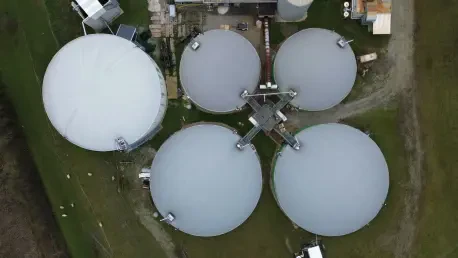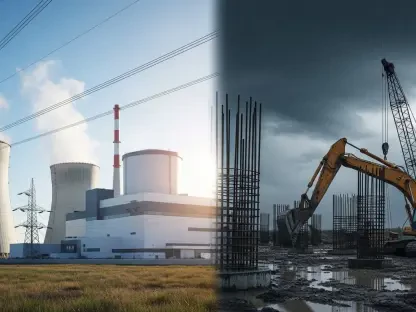What happens when a promise of green energy turns into a nightmare for an entire community? In the rural heart of Punjab, India, villages like Mushkabad are locked in a battle against a biogas plant that many fear could poison their air, water, and soil, raising a profound question about sustainable development. Day after day, residents stage hunger strikes, their voices echoing a critical concern: can sustainable development truly be sustainable if it risks the very lives it aims to improve? This unfolding drama is not just a local issue but a stark reflection of the tension between industrial progress and human well-being.
A Village in Revolt: Mushkabad’s Stand Against a Biogas Threat
In the quiet fields of Mushkabad, a storm of resistance brews. Around 10 villagers, men and women alike, take turns in a relentless chain hunger strike, their protest a raw display of desperation against a biogas plant under construction. Led by former sarpanch Malwinder Singh Lovely and current sarpanch Sarabjit Kaur, the community accuses the state government of turning a blind eye to their fears of environmental ruin.
This isn’t merely about halting a project; it’s about survival. For these residents, the plant symbolizes a looming disaster that could contaminate their drinking water and farmland, threatening their health and livelihoods. The intensity of their actions—sitting under the scorching sun, day after day—paints a vivid picture of a community pushed to the edge, unwilling to let progress come at the cost of their future.
Why the Outcry? The High Stakes of Biogas in Punjab
The fierce opposition in Mushkabad isn’t born out of mere speculation; it’s rooted in Punjab’s long history of environmental struggles. This region, often called the breadbasket of India, depends heavily on clean water and fertile soil for agriculture, which sustains millions of livelihoods. Yet, industrial projects have repeatedly scarred this landscape, leaving behind polluted rivers and health crises that linger for generations.
Biogas plants, marketed as eco-friendly solutions to manage crop residue and produce energy, are now under scrutiny for their potential downsides. Villagers worry that unchecked emissions and waste could replicate past disasters, where industrial pollution led to spikes in respiratory and waterborne diseases. This clash between the promise of green technology and the reality of rural life fuels a growing unease across Punjab’s countryside.
Unpacking the Risks: Health and Environmental Fears in Focus
At the core of Mushkabad’s resistance lie concrete concerns about health and environmental damage. Residents fear that toxic emissions from the biogas plant could pollute the air they breathe, while wastewater seepage might poison groundwater, a critical resource for drinking and irrigation. Such contamination could trigger serious illnesses, from asthma to dysentery, impacting not just humans but livestock as well.
Soil degradation is another pressing worry. Pollutants from the plant could render farmland infertile, striking at the heart of Punjab’s agrarian economy. A haunting example comes from Ghungrali Rajputan near Khanna, where a similar facility allegedly caused widespread contamination, with toxins seeping into the food chain. This precedent looms large over Mushkabad, turning abstract fears into a chilling possibility of history repeating itself.
The stakes are high, and the community’s apprehension is backed by grim statistics. Studies in regions with industrial biogas projects have shown a notable increase in waterborne diseases, with some areas reporting up to a 30% rise in related health complaints over a five-year period. These numbers transform local protests into a desperate plea for safeguarding life itself against unchecked industrial ambition.
Voices of Resistance: A Coalition Rises in Punjab
The fight in Mushkabad is far from isolated; it resonates across neighboring villages like Tapprian, Akhara, and Bhundir, where a coalition of voices amplifies the call for justice. Trade unions, farmers’ groups, and political organizations have rallied behind the protesters, forming a regional front against what they see as a dangerous gamble with public health. Their unity underscores a shared belief that the risks of biogas plants far outweigh their benefits.
Adding depth to this movement are academic insights that lend credibility to local fears. A documentary by students from Punjabi University highlights the release of hazardous chemicals from such plants, potentially linked to severe conditions like cancer. “Progress shouldn’t mean poison for our children,” remarked a protester during a recent rally, encapsulating the raw anger and betrayal felt by many who see government priorities skewed toward profit over people.
This chorus of dissent isn’t just emotional—it’s strategic. Activists and community leaders are leveraging media and public forums to spread their message, ensuring that the plight of these villages reaches policymakers. The personal stories of farmers fearing for their crops and parents worried about their families’ health weave a compelling narrative of resistance that demands attention.
What Can Be Done? Crafting a Safer Future for Biogas Projects
Amid the escalating tensions, solutions are urgently needed to bridge the gap between industrial goals and community safety. One critical step is enforcing stricter oversight, with mandatory environmental impact assessments before any biogas project breaks ground. Robust regulations must ensure that pollutants are contained, preventing the kind of disasters seen in places like Ghungrali Rajputan.
Transparency is equally vital. Governments and industries should initiate open dialogues with affected communities, holding public hearings to address fears and build trust. Incorporating advanced waste treatment technologies could also mitigate risks, learning from past failures to design safer systems that prioritize environmental protection.
Education plays a pivotal role as well. Supporting initiatives like the Punjabi University documentary can raise awareness among both the public and decision-makers about the hidden dangers of biogas plants. From 2025 onward, a concerted effort to fund research and community engagement programs could pave the way for policies that balance development with the well-being of Punjab’s people, turning conflict into a blueprint for collaboration.
As the hunger strikes in Mushkabad unfolded, they left an indelible mark on the discourse surrounding sustainable energy in Punjab. The unified stand of villagers, backed by regional allies and academic warnings, highlighted a critical oversight in industrial planning. Looking back, their struggle served as a reminder that progress must never sideline human lives. Moving forward, policymakers and industries must commit to rigorous safeguards, transparent communication, and community involvement to ensure that biogas projects protect rather than endanger. Only through such deliberate steps can the promise of green energy align with the reality of safe, thriving communities.









